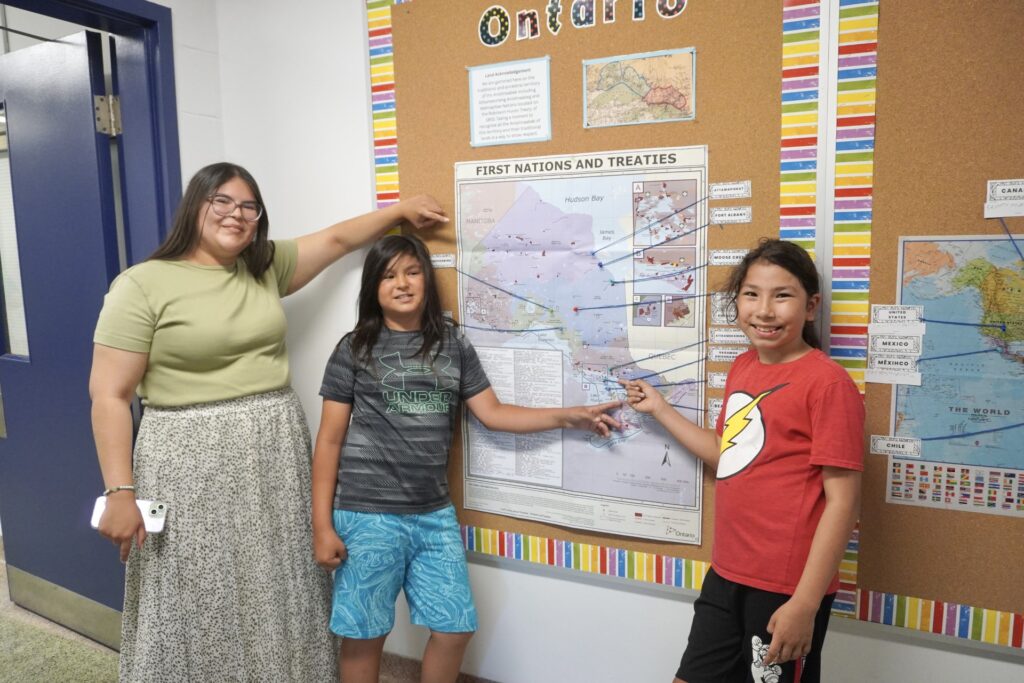
By Rosalind Russell – The Rainbow District School Board is acknowledging Treaties Recognition Week.
Board education director Bruce Bourget says staff and students in Rainbow Schools have access to a resource for schools to support the commitment to truth and reconciliation adding ongoing learning about treaties and the treaty relationship will further that commitment.
He says the province passed legislation in 2016 that recognizes the importance of treaties, brings awareness to treaty relationships between Indigenous and non-Indigenous peoples in Ontario, and bridges understanding between treaty partners.
Treaties Recognition Week was implemented in response to the 94 Calls to Action identified in the Final Report of the Truth and Reconciliation Commission.
A.B. Ellis Public School
Students from A.B. Ellis Public School will explore treaties including the Robinson-Huron Treaty, the meaning of treaties, as well as our collective responsibility to continue the journey of healing and reconciliation with Indigenous Peoples. Information will be shared during daily announcements, and classroom discussions will continue with read alouds to encourage students to make connections and ask questions. Some classes will explore the book “We Are All Treaty People” and will design wampum belts that represent friendship promises.
Assiginack Public School
During Treaty Recognition Week, staff and students at Assiginack Public School will support the ongoing work and commitment to Truth and Reconciliation by learning about treaty rights through First Nation stories, multimedia resources and inquiry-based learning. Grade 4 students will read “A Promise is a Promise”, examine the “A Dish with One Spoon” treaty wampum belt, and build it with LEGO. After examining oral memory images, students will design their own “Promise Treaties”. In Grade 7/8, students will read from “Indigenous Life in Canada” to explore the idea of core beliefs of First Nation Peoples related to land and land use, the core beliefs of European settlers related to land and land use, and how these beliefs differ. All students will engage in discussion and reflection about the importance of treaties to increase awareness of the treaty relationships between Indigenous and non-Indigenous communities.
Central Manitoulin Public School
Students from Central Manitoulin will continue to build on their knowledge and understanding of treaties. Students will engage in daily opportunities for learning and reflection through lessons, morning announcements and books including “We Are All Treaty People” by Maurice Switzer. Students will learn about Manitoulin Island treaties while watching videos of Indigenous speakers sharing their knowledge about the importance of treaties.
Little Current Public School
During Treaty Recognition Week, staff and students at Little Current Public School will support the ongoing work and commitment to Truth and Reconciliation by learning about treaty rights through First Nation stories, multi-media resources and inquiry-based learning.
Manitoulin Secondary School
Students in the First Nations, Métis and Inuit in Canada class will continue studying treaties, including wampum belts in the 1700s, the Royal Proclamation of 1763, the Robinson-Huron Treaty of 1850, the James Bay and Northern Québec Agreement, and a detailed analysis of the Treaty of Manitoulin Island from 1862. Segments of the book “We are All Treaty People” will be enjoyed in period 1 classes detailing history from the long foreseen arrival of Europeans to the Treaty of Niagara, war of 1812 and subsequent treaties. A treaty display will be posted in the Three Fires Room with resources about Indigenous Veterans who will be honoured on Indigenous Veterans’ Day – November 8, 2024.
S. Geiger Public School
S. Geiger Public School students will participate in various activities to deepen their understanding of treaties and engage in conversations about promises. Students will read “Dakota Talks About Treaties” and “Alex Shares His Wampum Belt” by Kelly Crawford. Students will design their wampum belts to represent class treaties. Other activities include making bracelets to join together to represent the unity of treaties and friendships.

 Submit News Tip
Submit News Tip